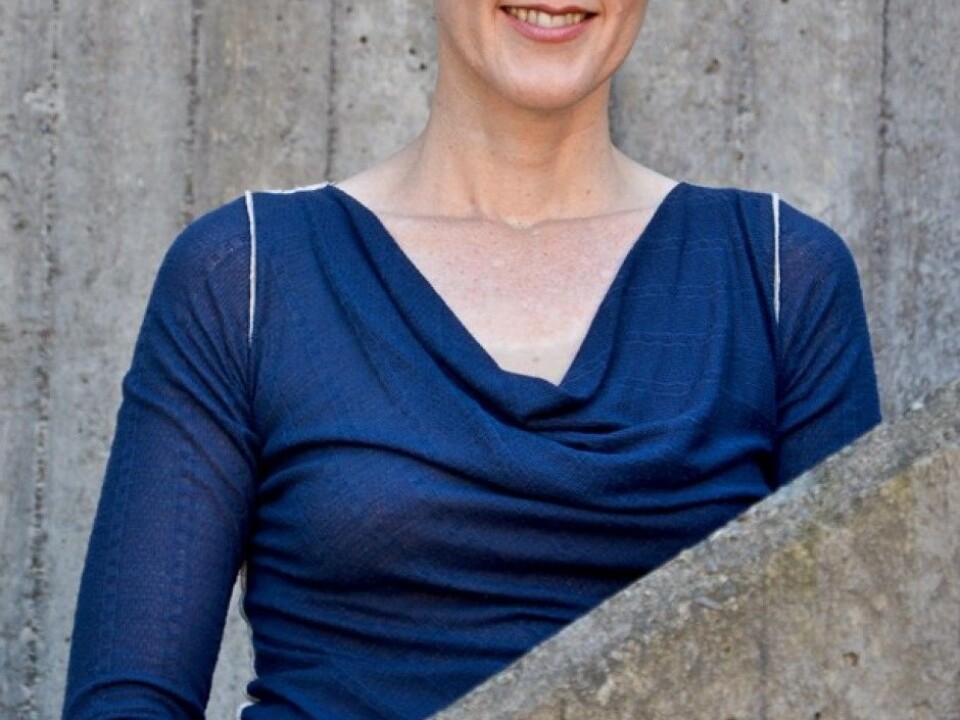An article from KILDEN Information and News About Gender Research in Norway

Blond, sexy and immigrant
Migration equals boat refugees, asylum seekers, poverty, domestic workers, and racism in the new country. But migration is also beautiful Swedish women who find it easy to succeed in the United States.
Denne artikkelen er over ti år gammel og kan inneholde utdatert informasjon.
“The US is a crazy country. It's almost impossible not to succeed here! ”, says Ebba, 43, who moved from Sweden to the US five years ago.
Migration is often associated with problems and difficulties. People who shouldn’t move, but who do so nevertheless. Roma people for instance, are referred to as migrants in Europe, even though they are traveling freely around in accordance with EU regulations on free movement within Europe.
White people on the other hand, move freely and without problems throughout most of the world. And a Swedish passport is considered to be one of the most favourable when it comes to visa rules.
“Privileged migration is often referred to as mobility. And privileged migrants often convert their mobility into success. It's about time we start looking at and studying these people as migrants,” says sociologist Catrin Lundström.

“The most important point of my project is showing that Swedes are migrants as well, that emigrate and immigrate. That we are all part of a global power structure, where we are the privileged ones.”
Privileged immigrants
Lundström’s book White migrations is based on several years of research, field work, and interviews with Swedish women who have migrated to the US, Singapore and Spain.
Migration research often explains discrimination, racism and negative social mobility in the new country with the fact that people have migrated. As if migration in itself is decisive for the opportunities in the new country. Lundström’s research shows that this is not the case.
“In the US, the white skin colour enhances the Swedish women’s position in society. In Singapore, the western whiteness is challenged. Still both groups enjoy the global privileges which are constructed around and have encompassed European whiteness since colonial times.”
Swedish, white and liberated

In the US, being Swedish is particularly good. Lundström’s 33 Swedish interviewees in the US told her that they are perceived as hard-working, interesting, and trustworthy.
In 1923, American professor of psychology Carl C. Brigham claimed that the Swedish were the whitest of all Europeans. Their blood was 100 per cent Nordic. Norwegian blood in comparison was only 90 per cent Nordic. According to Lundström, this perception of Swedes as particularly white is still prevalent.
“There exists a perception of whiteness which benefits Swedish migrants.”
In addition they are regarded as beautiful, and the idea of the sexually liberated Swedish woman from the 1960s is still in force.
“The women navigate between pure whiteness and exotic sexuality,” says Lundström.
This combination attracts successful American husbands, and the Swedish women often end up as stay-at-home mothers.
Safety in swedish citizenship
The US, Singapore and Spain were selected because they are central, but also very different, destinations which represent various types of Swedish migration. The women were found through the Swedish Women's Educational Association, SWEA.
“The association probably attracts a certain type of women. SWEA is regarded as a bit posh and upper class. This may explain why so many of the women I interviewed were housewives,” says Lundström.
Each year approximately 2000 Swedes migrate to the US. Almost sixty per cent of them are women. Lundström’s interviewees had come to the US either as students or as au pairs and ended up married to an American husband, or they came to the US accompanying their Swedish husband.
Approximately 1700 Swedes live in Singapore. Most of these work in a Swedish or international company, or they are accompanying spouses such as Lundström’s informants. In Spain there are between 17 000 – 65 000 Swedish residents. They are often referred to as ‘lifestyle migrants’ who search for a better life in warmer climates.
Within migration studies it has often been assumed that it is important to gain citizenship in the new country. But it depends where you migrate from. Only three of the 66 interviewees had changed their citizenship, the rest were still Swedish citizens.
“They consider it a guarantee for their future, when they get older or in case they end up unemployed or are diagnosed with a disease. As one of them told me, when you get cancer you move back home,” says Lundström.
Not as posh as Chinese whiteness
In the US Swedish women were the whitest of the white, and they were sometimes over-sexualised. But Swedish whiteness did not fit into society in Singapore at all.
According to Lundström there is much focus on whiteness in Singapore. Ads for skin whitening products are common, and whiteness is the ideal. But the ideal of beauty is not a white, blond western woman.
“Western women were ranked below the Chinese in the racial hierarchy. The western whiteness is not as posh as the Singaporean, Chinese whiteness,” says Lundström.
Swedish women in the US were very preoccupied with American men, whereas the Swedish women in Singapore were not the least interested in Asian men. They focused on their Swedish husbands. Asian women, on the other hand, represented a possible rival, since Swedish men found Asian women attractive.
“The Swedish women in Singapore were almost desexualised. They felt less feminine,” says Lundström.
But on the other hand they didn’t have to relate to local beauty standards. Most of the 13 women who lived in Singapore were accompanying spouses to working husbands. Their husbands’ job contracts included a house with a maid, swimming pool and tennis courts.
“They were not integrated in the Singaporean community. They lived an expat life with other expat wives, and created their own separate community.”
The term expatriate simply refers to a person who has migrated to a foreign country to live. However, it usually refers to privileged migrants, who are often diplomats or have other well-paid jobs abroad. In the Singaporean expat community the white, blond, Swedish woman was still a beauty ideal.
Gender equal luxury lives
The women in Singapore were often well educated women who had decided to take a career break in order to accompany their husbands abroad.
Many of the interviewees said that they were exhausted after managing both a career and small children back in Sweden. In Singapore they became economically dependent on their husbands, but the ideal of gender equality was still important to them.
“In order to maintain this ideal they had a maid,” says Lundström.
Their husbands’ share of the house work was outsourced to a poor woman from another Asian country.
“This made them feel less like accompanying spouses who were economically dependent on someone else.”
It did not however provide any status.
“There are no positive ideals connected to being an expat wife in Singapore. You can’t phone home to Sweden and brag about being someone’s housewife.”
One Swedish woman was called a parasite by her family, because she just lived a luxury life on her husband’s money without contributing at all.
Super-housewife in the US
Being a housewife in the US however, is associated with status.
“In the US it is regarded as a positive thing if your CV shows that you’ve been home with your children for 15 years,” says Lundström.
If you belong to the white privileged class in the posh suburbs, that is.
“Many did not plan to become a housewife and most of the housewives are well educated. But they are forced to make a choice when they have children due to an expensive and poorly developed child care service.”
Several of the Swedes in the US thought that gender equality had gone too far in Sweden. They thought the Swedish gender equality project had turned into a perfection project, requiring you to be both successful and beautiful, with a toned body, a family and children all at once.
In the US the partners consider themselves equal by sharing the work. He makes the money while she takes care of the family. Moreover, the housewives do not stay at home and do housework all day, that's what maids are for. The American housewives do charity work in their spare time.
Discovered their own whiteness
Lundström’s informants spoke about being women. They related to a Swedish gender equality ideology. Talking about the colour of their skin was more difficult. “Being white is the same everywhere,” said 60 year old Birgitta, who had just reflected on the fact that being black could be experienced differently in different contexts.
Some of the women discovered that they were white for the first time when they migrated, since they moved from Sweden to a country where their whiteness was not the norm.
“One aspect of whiteness is that you do not stand out, you are not noticed. This makes it difficult to study white people’s experience of whiteness,” says Lundström.
“This invisible state of whiteness is of course disrupted when people reach out to touch your hair or when you’re not white in the right way, as the women I interviewed in Singapore.”
And it was obvious that whiteness and Swedishness are interlinked.
The blond Swedish women in the US bleached their hair in order to appear even blonder as if to completely fulfill the expectation about the ideal white Swedish woman. Those who had dark hair commented that they perhaps looked a bit Brazilian.
Changing colourblind migration research
Lundström’s book about white migration is one of very few works on the topic. Her ambition is to influence the migration research field and end its colourblindness.
She wants other researchers in the field to see how race, gender, class, history and background affect and govern migration and migration experiences.
As white people in the world these women are privileged, but Lundström emphasises that both poor and rich women who migrate often end up in the domestic sphere, either as housewives or as maids.
Translated by: Cathinka Dahl Hambro


































